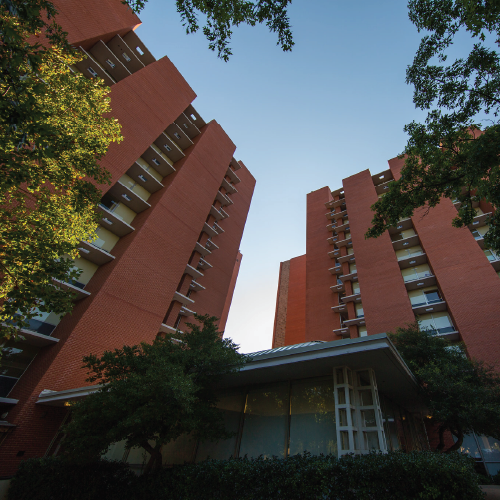Approximately 25% of all students living in OU housing will receive an email by Sept. 20 with more information and a link to schedule a testing appointment, which will be offered from 10 a.m.-6 p.m. on Sept. 21-24 in Cate Center 3.
The new testing strategy complements other measures OU has adopted to limit the spread of COVID-19 in its congregate housing and throughout the campus community.
“By testing a representative sample of students who are asymptomatic, we can better pinpoint the presence of the virus and limit its transmission,” said OU Chief COVID Officer Dr. Dale Bratzler. “Combined with our existing protocols, the expansion of our surveillance testing adds yet another layer to the university’s broad strategy to curb the spread of the virus.”
OU will offer a self-administered, less invasive anterior nasal swab test that collects specimens from the front of the nose. Students will be notified of their results within 24-48 hours, and students who receive a positive test will be provided guidance on isolation, contact tracing and instructional continuity. Tests will be provided at no cost to students.
Students will not be expected to participate if they have: 1) previously tested positive through the saliva-based pre-arrival testing; 2) received a positive test at Goddard Health Services; 3) submitted the online COVID-19 screening form to Goddard Health Services following a positive test performed off-campus; or 4) are currently in quarantine due to exposure.
As the university continues to monitor testing data and trends, it is possible that additional randomized groups of residential students will be contacted after next week’s expanded surveillance testing window. The voluntary testing launched earlier this month, also offered in Cate Center 3, is still available at no cost for all residential students.
Other elements of OU’s approach to COVID-19 include:
- Voluntary student testing program: Students living in OU housing who are not reporting symptoms of COVID-19 may participate in the voluntary testing program at Cate Center 3.
- Wastewater analysis: OU researchers are conducting regular sampling of wastewater from across campus to help identify areas experiencing higher levels of the virus.
- COVID-19 dashboard: OU launched an online dashboard, available at ou.edu/together/dashboard, to track COVID-19 testing data on the Norman campus – a community of more than 38,300 students, faculty and staff.
- Masking requirement: OU has subscribed to a university-wide masking policy, which applies to faculty, staff, students and campus visitors across all three campuses. Students and employees have been provided various types of face masks appropriate to their on-campus responsibilities.
- Chief COVID Officer: OU appointed Dr. Dale Bratzler, a nationally leading expert in infectious diseases and public health, to advise the university on its planning efforts with regard to the virus.
- COVID-19 testing requirement prior to move-in: OU required all students moving into on-campus housing to be tested for COVID-19 before arriving on campus.
- COVID-19 curbside testing: Any OU student, faculty or staff member may schedule a free COVID-19 test through OU Health Services.
- Social distancing: Classrooms, workspaces and common areas across campus have been configured to promote social distancing.
- Mandatory online health screening: All OU employees and students must complete the online screening form prior to returning to campus or any time certain scenarios apply.
- Enhanced cleaning: Through Clean and Green, OU’s campuses are meticulously cleaned to support the healthiest environment possible. Daily cleaning protocols have been enhanced, with particular emphasis on touch points and common areas.
- Microbe-fighting devices for residence hall towers: Every room in Adams, Couch and Walker Centers is being equipped with a wall-mounted Synexis® Sphere device, which continuously produces Dry Hydrogen Peroxide (DHP™) to reduce viruses, bacteria and fungi in occupied spaces.
- Facility upgrades: Touchless, motion-sensor fixtures have been installed in public restrooms, air filters have been upgraded to hospital-grade standards and more hand sanitizer stations have been installed across campus.
- Classroom and instructional modifications: OU’s goal is to provide in-person instruction to the greatest extent possible while promoting a safe and secure campus environment. To help accomplish this, class times have been extended throughout the day, and larger classes have been moved online.
For the latest information on Norman campus operations, visit ou.edu/together.



